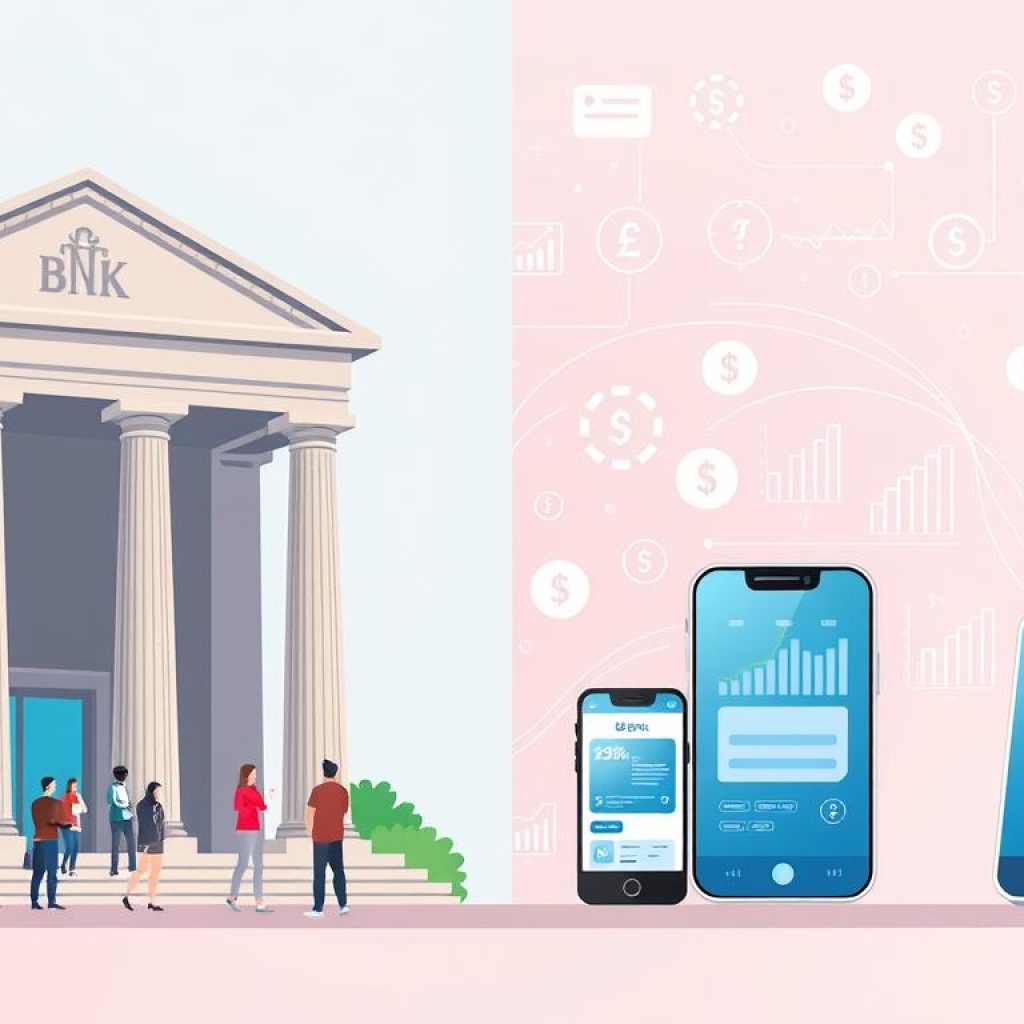The banking world is changing fast, thanks to fintech, digital banking, and financial technology. Traditional banking faces many challenges. These include old systems and changing what customers want. Fintech is key in helping banks keep up with these changes.
Fintech, digital banking, and financial technology are opening new doors. They help banks grow, work better, and connect with customers. Looking at the 10 big challenges for traditional banking, fintech’s role in making things better is clear.
Key Takeaways
- Fintech is changing banking with new ideas and digital tools.
- Traditional banking faces big hurdles, like old systems and changing customer needs.
- Digital banking and financial technology are driving growth and efficiency in banking.
- Fintech helps banks stay ahead in a fast-changing world.
- The future of banking will be shaped by fintech, digital banking, and financial technology.
- Adapting and innovating are key for traditional banks to stay relevant in the digital age.
The Evolution of Banking: From Brick-and-Mortar to Digital Revolution
The banking world has changed a lot over time. This change is thanks to Banking Innovation and new tech. Now, we have digital banking instead of old-fashioned banks. This change is because of Mobile Payments and other digital ways to pay.
It’s important to know what’s behind these changes. Some key things include:
- More people using digital banking
- More people wanting Mobile Payments and digital ways to pay
- New tech like blockchain and artificial intelligence in Banking Innovation
New digital Financial Services have made the banking world more competitive. New companies are coming in to challenge old banks. Banks need to keep up by using Banking Innovation and digital tech. This way, they can offer better services and keep their customers happy.
The future of banking will depend on how well banks can innovate and meet customer needs. By using Financial Services and Mobile Payments, banks can grow and stay ahead in a fast-changing market.
| Traditional Banking | Digital Banking |
|---|---|
| Brick-and-mortar branches | Online and mobile banking platforms |
| Limited hours of operation | 24/7 access to banking services |
Legacy Technology Systems: The Achilles’ Heel of Traditional Banks
Traditional banks face big challenges in keeping up with modern digital services. They struggle with legacy technology systems that are outdated. These systems make it hard for banks to change and meet customer needs.
Legacy technology also creates big Cybersecurity risks. As new tech comes out, old systems can’t keep up with security needs. This leaves banks and customers open to cyber threats, risking their data and money.
To overcome these hurdles, banks need to focus on Banking Innovation. They should use new tech and strategies to stay competitive. Working with fintech companies can help banks improve security and customer service.

- Cloud-based services for better flexibility
- Artificial intelligence and machine learning for better customer service and risk management
- Blockchain technology for safer and more transparent transactions
By adopting these innovations and leaving old tech behind, banks can thrive in the digital world. They can offer customers the modern, secure, and easy banking they want.
The Customer Experience Gap in Traditional Banking
Traditional banks are struggling to meet their customers’ changing needs. Digital banking has raised the bar for a seamless and personalized experience. The gap between what customers want and what banks offer is growing.
Studies show more people are turning to digital banking, especially mobile banking. To close this gap, banks need to invest in digital tools like artificial intelligence. This includes using chatbots, personalized marketing, and sending real-time alerts.
Digital-First Customer Expectations
Customers want a digital-first experience, able to access banking services anytime. Banks must create a strong digital platform for this. Key features include:
- Mobile banking apps with easy navigation and secure login
- Personalized account management and transaction tracking
- Real-time alerts and notifications for account activity

The Mobile Banking Imperative
Mobile banking is now essential for banks. Most customers use mobile devices for banking. Banks must focus on mobile banking to stay competitive.
By using artificial intelligence and digital tools, banks can offer a better experience. This can lead to more loyal customers and keep them coming back.
Regulatory Compliance and Security Challenges
Traditional banks face many challenges today. Regulatory compliance is key to keeping banks legal and earning customer trust. But, following all the rules can be very hard.
Cybersecurity is another big issue. As banks use more Financial Technology, they must keep their systems and data safe. This means spending a lot on security, like encryption and firewalls.
Some major security problems banks deal with include:
- Data breaches: Banks must keep customer data safe from hackers.
- Cyber attacks: Banks need to fight off attacks, like phishing and malware.
- Compliance with regulations: Banks must follow rules, like GDPR and PCI DSS.

To tackle these issues, banks can use Financial Technology with strong security and compliance tools. By doing this, banks can better follow the law and protect against cyber threats.
How Fintech Innovation is Reshaping Financial Services
Fintech innovation is changing the financial world. It’s thanks to new tech and how people want to use it. Blockchain makes transactions safer and clearer. Open Banking lets banks and fintech work together, creating better services for customers.
This change is making a big difference in many ways. For example:
- Automation and digital tools are making things more efficient and cheaper.
- Services are becoming more personal and easy to use on mobile devices.
- More people can now access financial services they need.
Fintech innovation is just getting started. With Fintech Innovation, Blockchain, and Open Banking, the financial world is set for a big shift. This change will help both customers and financial companies.

| Company | Innovation | Impact |
|---|---|---|
| PayPal | Mobile payments | Increased convenience and accessibility |
| Stripe | Online payment processing | Streamlined transactions and reduced costs |
| Ripple | Blockchain-based cross-border payments | Improved speed and security in international transactions |
These examples show how fintech can make a big difference. We’re going to see even more exciting changes in the future.
The Cost Structure Dilemma: Traditional Banks vs. Digital Solutions
Traditional banks struggle with their cost structure. This makes it hard for them to compete in the market. On the other hand, fintech companies offer digital solutions that are cheaper and more efficient. They use technology to cut costs and grow easily.
Some key benefits of digital solutions include:
- Lower infrastructure costs
- Reduced labor costs
- Improved automation and efficiency
These benefits let digital solutions price better and serve customers more effectively. This can shake up the traditional banking model.
The use of financial technology in digital solutions also leads to more creative and personalized services. These services are made to fit what each customer needs. Traditional banks, however, often stick to a set way of doing things.

In summary, the cost structure of traditional banks is a big problem they must solve to stay competitive. By using digital solutions and financial technology, they can lower costs and work better. This could help them offer services that are more appealing to their customers.
| Traditional Banks | Digital Solutions |
|---|---|
| High infrastructure costs | Lower infrastructure costs |
| High labor costs | Reduced labor costs |
| Limited automation and efficiency | Improved automation and efficiency |
Data Management and Analytics: Bridging the Gap
Effective data management is key for banks to make smart decisions and better services. Fintech solutions help banks use real-time analytics to understand customer behavior. This lets them offer services that fit each customer’s needs, boosting satisfaction and loyalty.
With predictive banking solutions, banks can guess what customers might need next. This makes the customer experience better and helps banks spot risks and chances. Also, data management is crucial for keeping customer data safe and accurate, which builds trust and keeps banks in line with rules.
Some main benefits of using analytics in banking are:
- Improved customer insights
- Enhanced risk management
- Increased operational efficiency
- Personalized services
By using predictive banking and data management, banks can close the gap between old banking and new digital services. This keeps them competitive, boosts customer happiness, and grows their business. As banking keeps changing, the role of analytics and data management will grow too.
By using these technologies, banks can focus more on customers. This leads to lasting success and growth in the banking world.
| Benefits | Description |
|---|---|
| Improved Customer Insights | Gain a deeper understanding of customer behavior and preferences |
| Enhanced Risk Management | Identify potential risks and opportunities to minimize losses |
| Increased Operational Efficiency | Streamline processes and improve overall efficiency |
Workforce Transformation in the Digital Age
The banking sector is changing a lot as it moves into the Digital Age. Employees need to learn new skills and use new tech. This helps them offer better Financial Services to customers.
Some important parts of this change include:
- Upskilling and reskilling of employees to work with emerging technologies
- Adoption of agile work methodologies to enhance collaboration and innovation
- Emphasis on customer-centricity and personalized services
As the banking world keeps changing, it’s key for banks to focus on Workforce Transformation. This helps them stay ahead in the Digital Age and offer top-notch Financial Services.
By investing in their team and using digital tech, banks can grow, work better, and give amazing customer experiences. This way, they can really succeed in the Digital Age.
Conclusion: The Future of Banking – Collaboration Over Competition
The banking world is changing fast with the digital revolution. But, the key to success is working together. Traditional banks and fintech companies can join forces. This way, they can improve customer service, make things more efficient, and stay ahead in the game.
Older banks have a lot of experience and strong rules to follow. Fintech startups are quick, use data well, and offer new ideas. When they work together, they can make banking better for everyone. It will be more tailored to what people need today.
This new way of banking needs a careful mix. Banks must keep things safe and secure. At the same time, they need to bring in new tech and focus on customers. This teamwork is the only way for banking to thrive in the digital age. It will make the industry stronger and more ready for the future.
FAQ
What are the 10 key challenges facing traditional banking in 2025?
Traditional banking faces many challenges in 2025. These include outdated technology and a gap in customer experience. There are also concerns about regulatory compliance and security. The rise of fintech innovation is another challenge.
Cost structures are a problem, as is managing data and analytics. Transforming the workforce is also a challenge. Lastly, banks need to work together rather than compete.
How is fintech innovation reshaping the financial services industry?
Fintech innovation is changing the financial services industry. It brings in new technologies like AI, machine learning, and blockchain. These advancements make banking more efficient and cost-effective.
They also improve the customer experience by offering personalized services and real-time analytics.
What are the advantages of fintech solutions over traditional banking?
Fintech solutions are more affordable and efficient than traditional banks. They use digital technologies and focus on customer needs. This leads to better customer experiences through personalization and real-time services.
How are fintech companies helping traditional banks overcome their challenges?
Fintech companies help traditional banks in many ways. They modernize technology, improve customer service, and enhance security. They also provide better data management and analytics.
Working together, banks and fintech can drive innovation and stay competitive.
What skills do bank employees need to adapt to the digital age?
Bank employees need new skills for the digital age. They should be good at data analysis and familiar with new technologies. They also need to work well in teams.
Transforming the workforce is a big challenge for traditional banks.
How can traditional banks and fintech companies work together effectively?
Collaboration is key for the future of banking. Banks and fintech can share their strengths to innovate and improve customer service. This way, they can stay relevant and competitive in the digital world.
How I Overcame the Top Challenges of Leading a Fintech Startup in 2025
5 Ways Attending Conferences Transformed My Understanding of Fintech in 2025
A Comparison of the Top 5 Fintech Apps in 2025: Which One Wins?
10 Innovations That Will Shape the Future of Fintech in the Next Decade
Why 2025 Could Be the Tipping Point for AI in Financial Services

